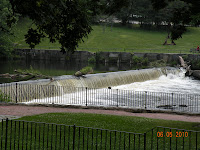Samuel Slater immigrated, from England when he was in his teens. At the time it was Illegal for anybody in his profession to come over to the United States. So he told his family that he was going to visit London, dressed up as a Farmer, boarded a ship and set off to Philadelphia. While on the ship the Captain told him about Rhode Island and the opportunities that Rhode Island had so he decided to settle there instead. In 1793 he built the first successful water powered Cotton Spinning Mill in North America, on the Banks of Blackstone River in Pawtucket Village. This was a major start to the Industrial Revolution.
Starting at the age of six, children would begin to work at the mill, boys would get around fifty cents per day and girls would get about thirty-five cents per day. Working at the Mill was very dangerous. It was not uncommon to break bones and even lose a finger or two. Being sick was not an excuse to not work, so a lot of disease was spread. It seemed that children were expendable, if one died you had more at home to take their place. Taking this tour made us grateful for the technology we have today, the era we are living in, and that we live in a place where these types of conditions are not allowed. I cannot imagine sending Keira off to work to at a plant/mill knowing that she might not be comming home.
The Cotton Mill is the Yellow building on on the right and the Machinery Mill is where they did wood and metal working on the left.
Dam that was built in the 1700's to have a constant flow of water for the mills.

Samuel Slater slept in the house while he was building his residence. It once housed twenty-three people, the chimney supported seven fireplaces, and was fully occupied until 1960 without a bathroom!!

1700's floorboard, this is why we couldn't see the upstairs.

A bucket like this was numbered and had a family's name on it. These buckets were used in case of a fire. When a neighbors house caught on fire, the neighbors would fill there buckets with water and send them on down, this was known as the bucket brigade. The numbers and the name would let the neighbors know who didn't send there bucket.

The Garden, which they try to keep like it would have been kept during that time.

An old Spinning Wheel.

Churning butter. . . or at least pretending to.

The Wheel

Opening the gate, to let in the water to run the wheel. They don't open the gate until the first customers arrive. Which was US!! For most of the tour it was just us as well!!

The Drive Shaft is made to turn by the wheel, which powers the whole plant.

Whale Oil Lamp.

One of the first standardized tap and dye machines. Before this they had to make screws by hand. They also used this to bore out holes for cannons and guns.



This bell was rung at five o'clock in the morning, signaling the workers that it was time to get up and come to work. At six-thirty it rang five more times. Then the doors were locked and you could not get in or out. The windows were nailed shut, the machines were kept running, the workers were not allowed to turn them off for anything. With the machines running all the time, the windows being nailed shut, and humidity made it pretty hot in the workshops. This is how the phrase Sweat Shop got started.

Cleaning the cotton, this machine separated the seeds and the outer shell from the cotton. Before this machine was invented this was done by hand and took a full hour to de-seed on pound of cotton. This machine decreased the amount of time taken to de-seed the cotton, thus making cotton more accessible to the general public. While cleaning the cotton by machine or by hand sent a lot of cotton fibers into the air, not wanting to lose any cotton the windows were kept nailed shut.

Cotton Bale, weighing in at five-hundred pounds.

I can't remember what this was called, but they used to straighten the cotton fibers before putting the cotton on the wheel.

Crank operated Spinning Wheel.

This machine took several spools of weak thread and spun them together to make stronger thread. The children's job for this machine was to make sure there were not any empty spools. The children had to take the spools off the machine while it was still running, as the machines were not allowed to be turned off. The bobbins moved very fast and the children would often get their fingers pinched, bruised, or even broken.





1 comment:
So interesting and sad in the same breath. I agree about living when we do now! Thank goodness.
Post a Comment